Welcome to a comprehensive exploration of the tactical intricacies that define Real Madrid under the stewardship of the seasoned Carlo Ancelotti. In this tactical analysis, we delve into the strategic framework, player roles, and dynamic formations that shape the identity of one of football’s most iconic clubs. Ancelotti’s wealth of experience and tactical nous have left an indelible mark on Real Madrid’s playing style. From defensive solidity to expressive attacking play, this analysis aims to unravel the nuances contributing to the team’s success. Join us on a journey through the tactics, formations, and player dynamics that make Real Madrid a force to be reckoned with under the guidance of Carlo Ancelotti.
Build-up
Low Build-up
In the low build-up, Carlo Ancelotti sets his team up in a 1-4-3-3 formation, with one lower number-six and two higher number-eights.
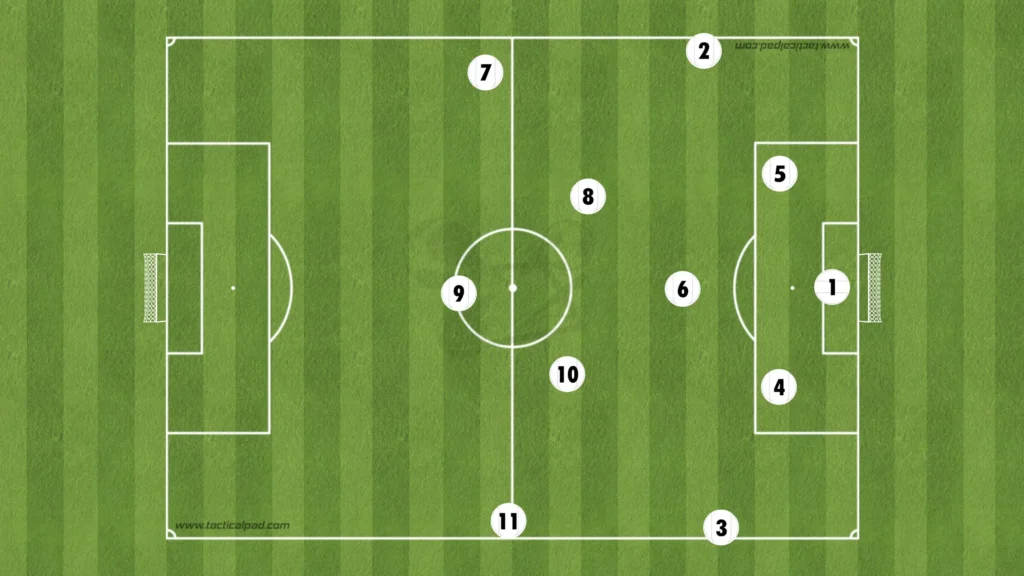
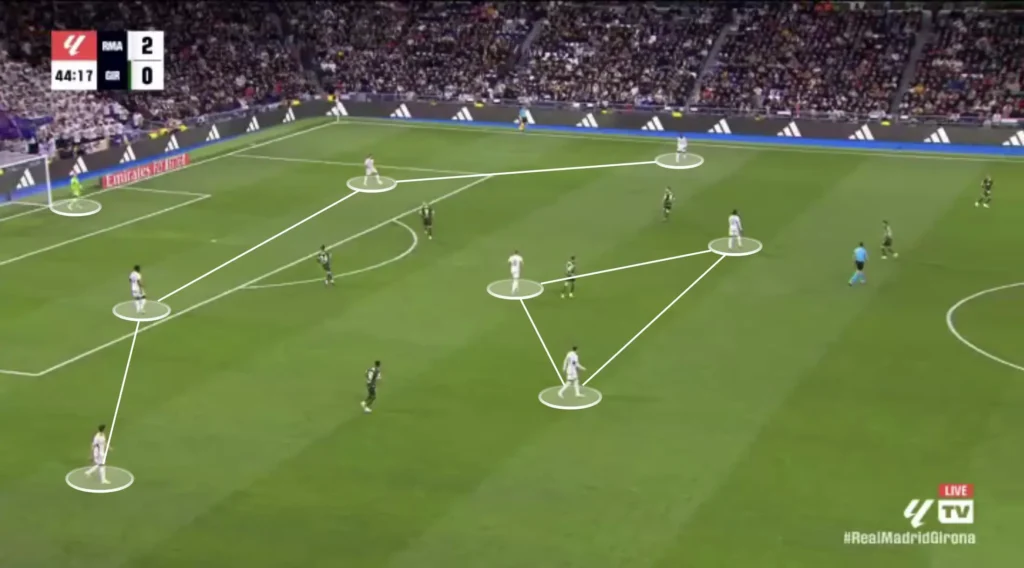
They often drop with the midfielders and like using the goalkeeper, which creates numerical superiorities, allowing them to beat the press.
High Build-up
In the high build-up, Carlo Ancelotti’s Real Madrid set up in a 1-2-3-5 formation, usually pushing the fullbacks up and the wingers inside:
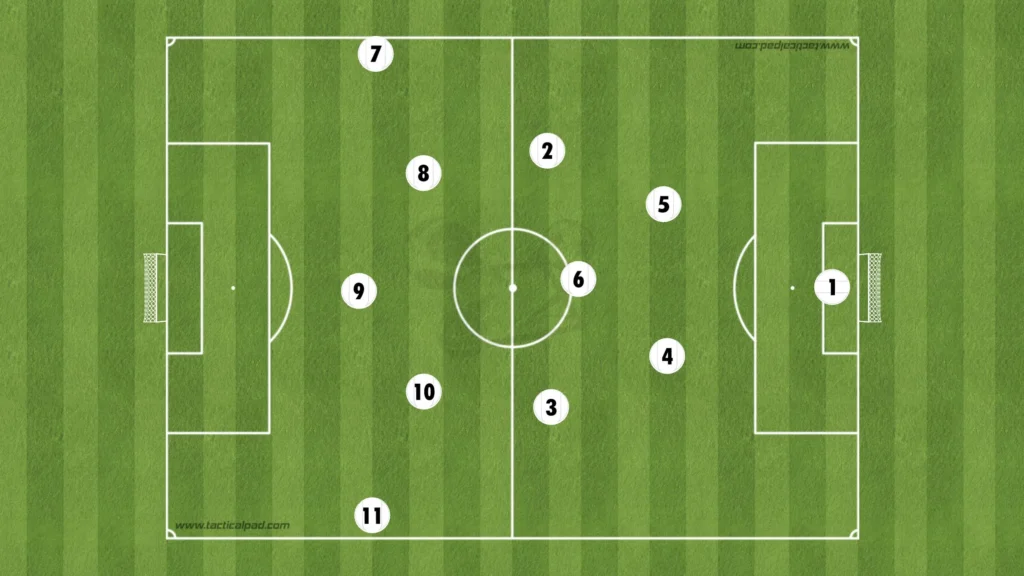
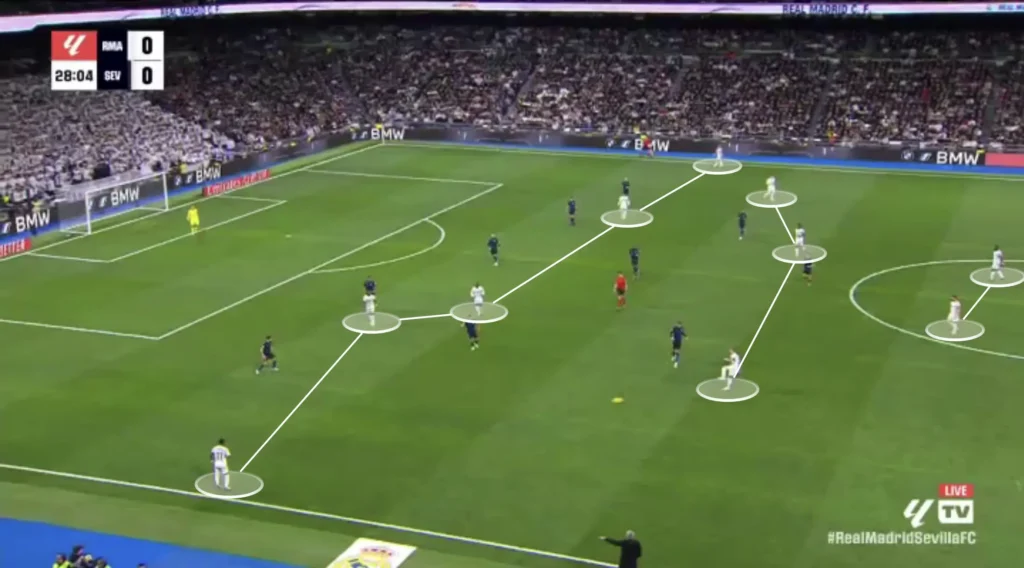
This gives them eight players in the central areas and one on each wing, which creates more options in the center and less space between the players. Ancelotti likes this because he prioritizes playing through the middle. He needs one player high and wide to pull apart the backline while the rest create numerical advantages in the midfield areas. This builds good conditions in defensive transitions, allowing more players to press when they lose the ball. Another purpose for keeping many players in the middle is to shorten the distance between them. This shortens the length of the passes, which naturally shortens the time between passes. This means the opposition players will have less time to push up and press, giving the Real players more time and control.
High Backline
A massive aspect of Real Madrid’s high possession build-up is they keep a high backline. This helps in the counterpress because they get closer to the center. Having more players close to the center who can win the ball back makes it difficult for the opposition to recycle possession. Furthermore, the high backline shortens the distance between players, shortening the time and length of the passes and preventing the opposition from pushing up their defense.
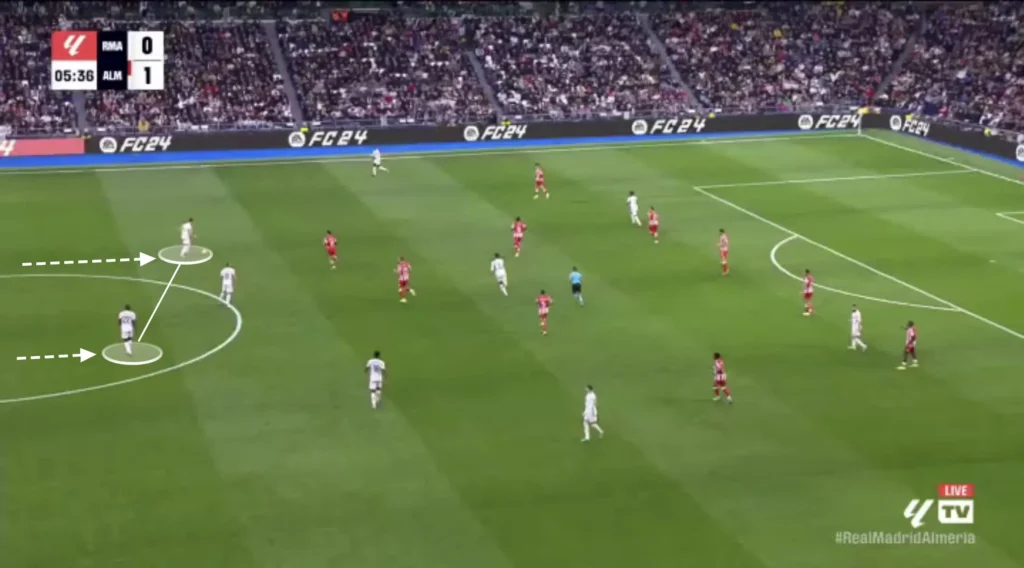
Finding the Pockets
Real Madrid always try to find the attacking midfielders in the pockets. Their midfield numerical superiority usually means that at least one will be open. They will look for passes from the back or the wing, breaking lines and finding an attacking midfielder. Being positioned in the pockets between the midfield and defense creates confusion for the defenders, who do not know who should mark the Real player.
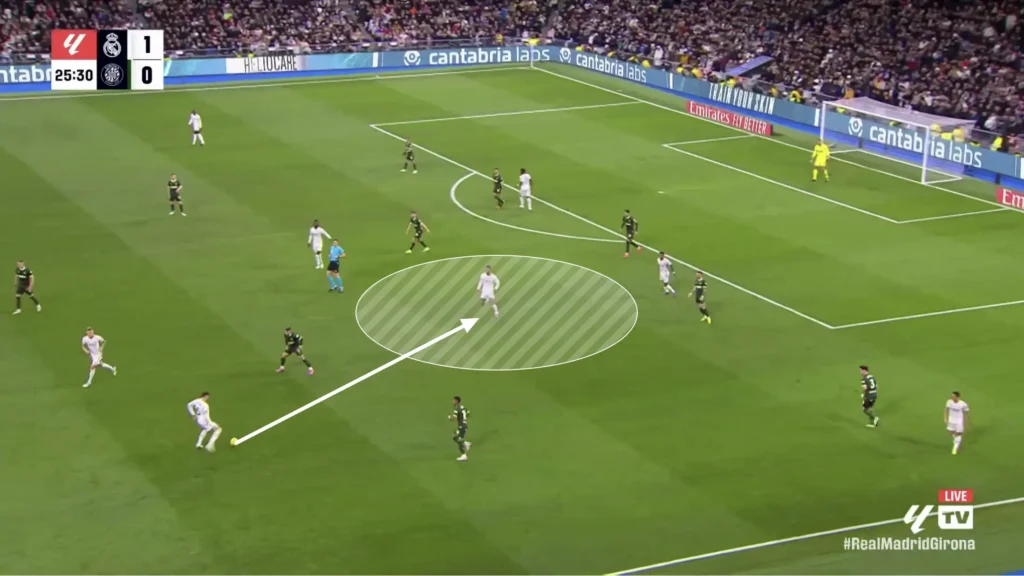
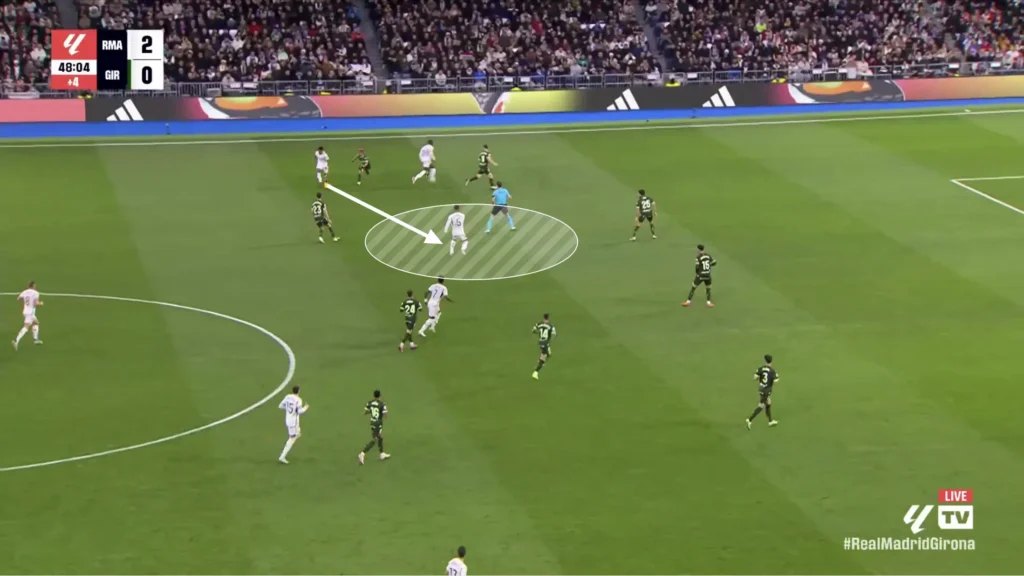
Getting the ball in these spaces allows the attacking midfielders to turn and attack the defense. Their technical brilliance enables many alternative ways of beating the backline and scoring from here.
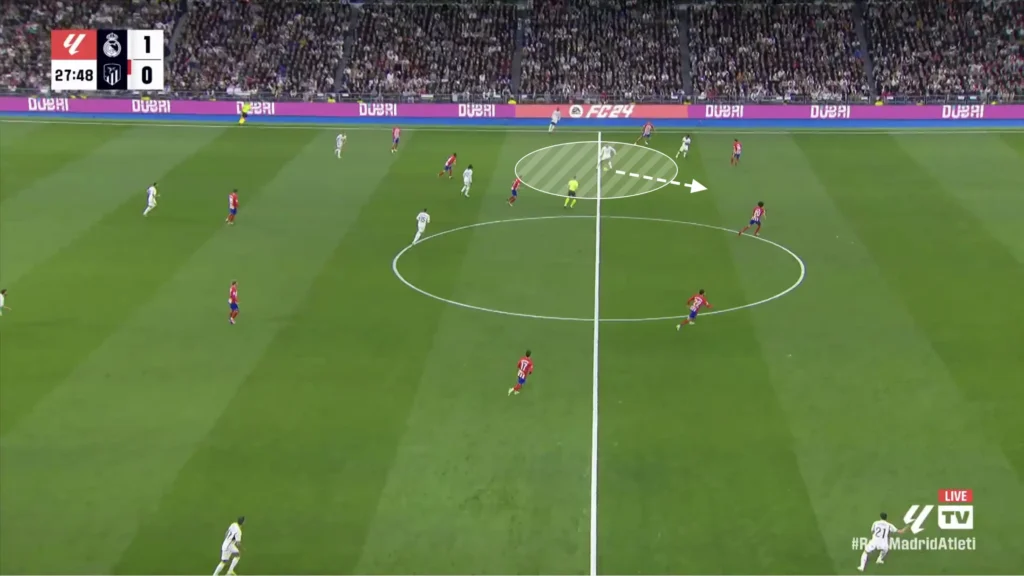
Final Third
Attacking the Half-Space
Real Madrid is an excellent team in the final third. They always create chances, primarily by attacking the space between the opposition center-back and fullback. They mainly do this from the wide areas with underlaps from midfielders.
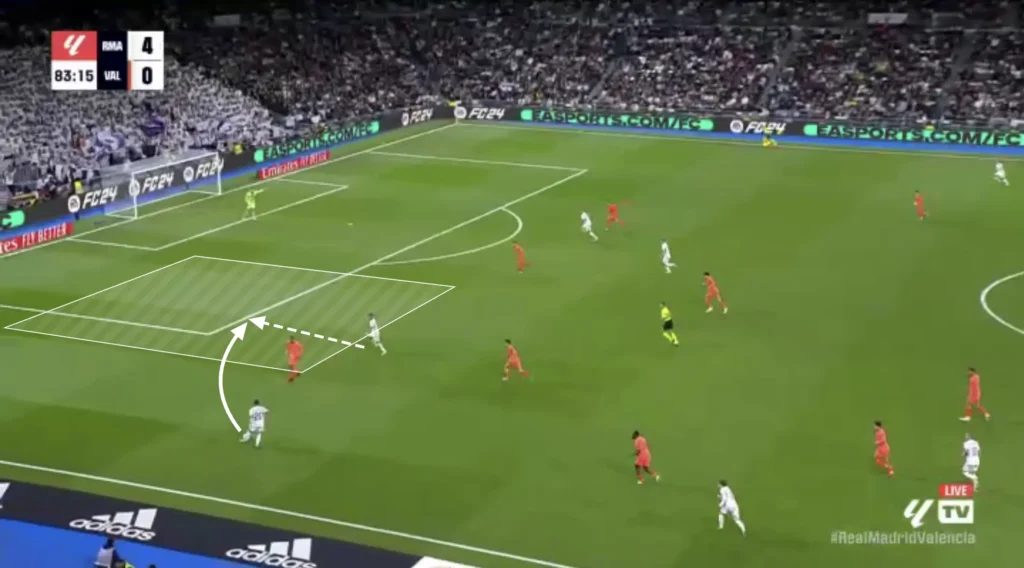
Overlaps
Real Madrid also uses the overlap to produce opportunities in the final third. When the winger gets the ball, a Real player quickly makes the overlap, creating a 2v1 on the wing. If the opposition fullback drops to cover the overlapping run, the winger could cut inside, taking a shot or combining with a midfielder. If the fullback covers the center, the ball can easily be played to the overlapping player, creating a crossing opportunity.
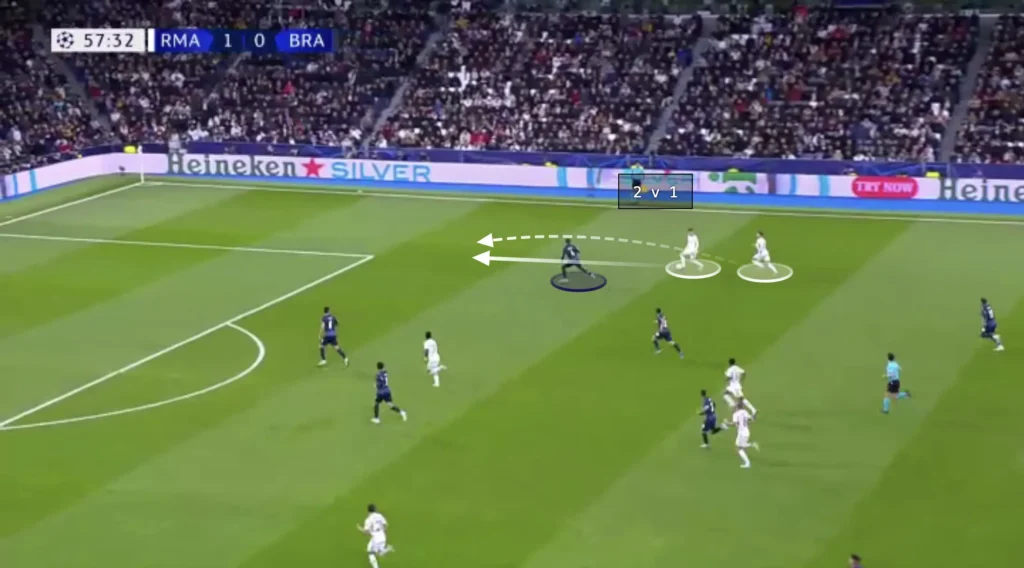
Runs in Behind
Real Madrid do not shy away from utilizing their quick attackers with through-balls in behind the opposition backline. This gives them another dynamic to their attacking style of play. If the opposition keeps a high backline, Madrid will use the space in behind. However, if they drop the backline to protect the dangerous space, the midfield opens up, which allows Madrid’s technical midfielders to play past the opposition.
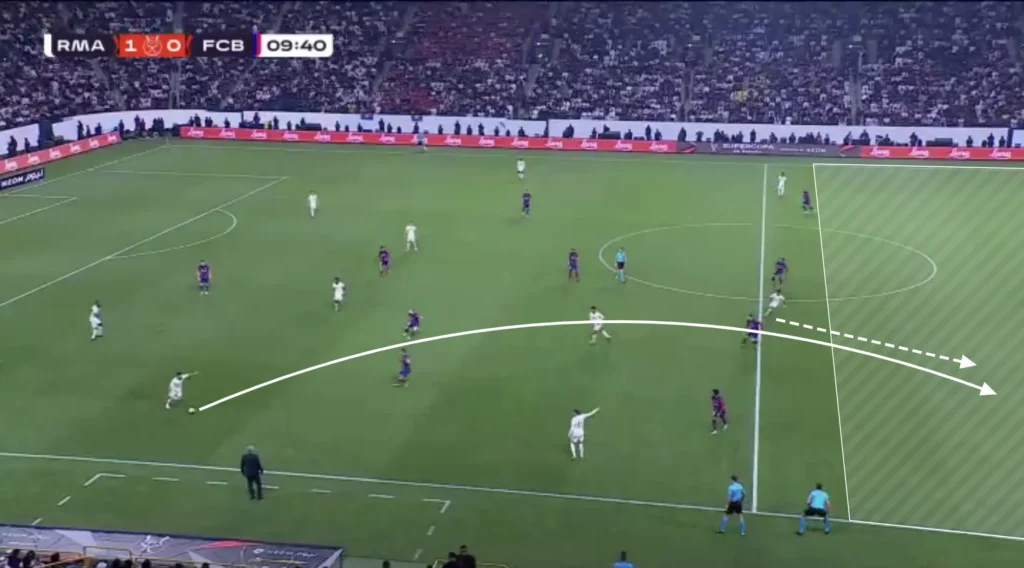
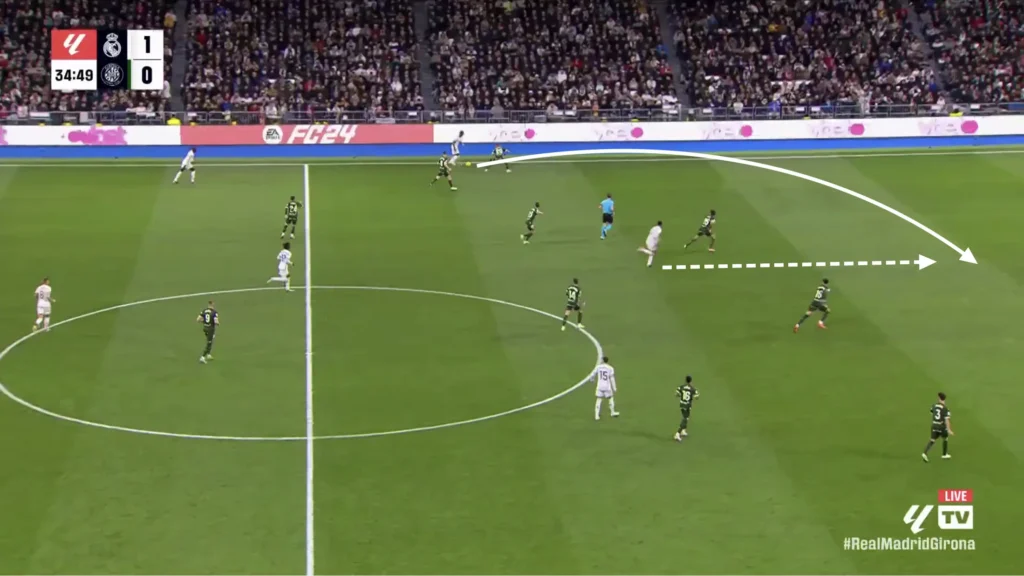
Many Players in the Box
The attacking midfielders and wingers also look to make runs into the box when the ball is in the final third, often getting four or five players into these areas to create overloads. The numerical advantages in the box force the defending team to make decisions and leave some players open.
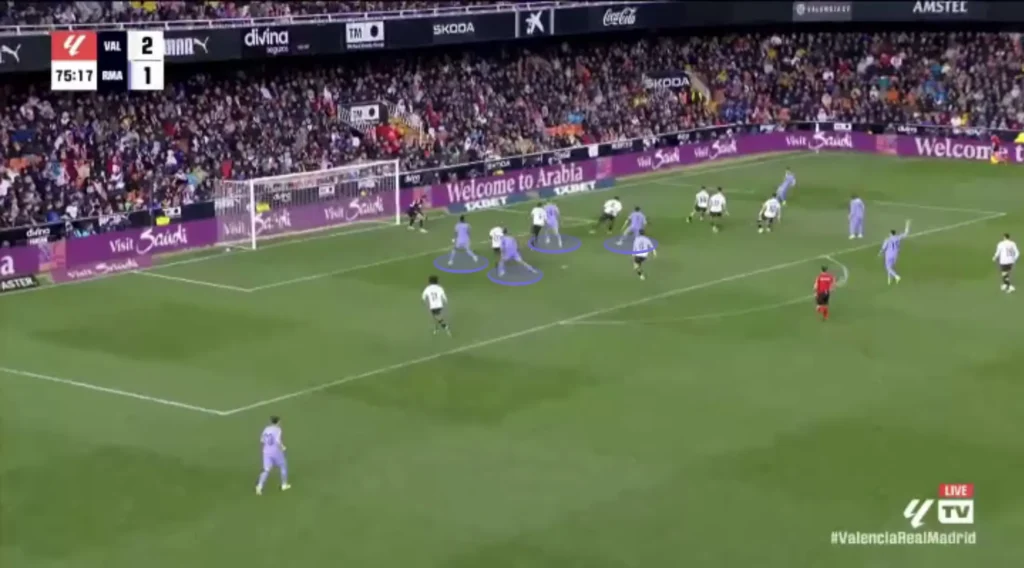
Carlo Ancelotti positions many Real Madrid players outside the box, ready for the second-balls and cut-backs as well. They often succeed in pushing down the opposition’s defense, which opens the space in front of the backline. Real Madrid will find players like Bellingham and Valverde in these spaces who can shoot or combine with an attacker to create goalscoring opportunities.
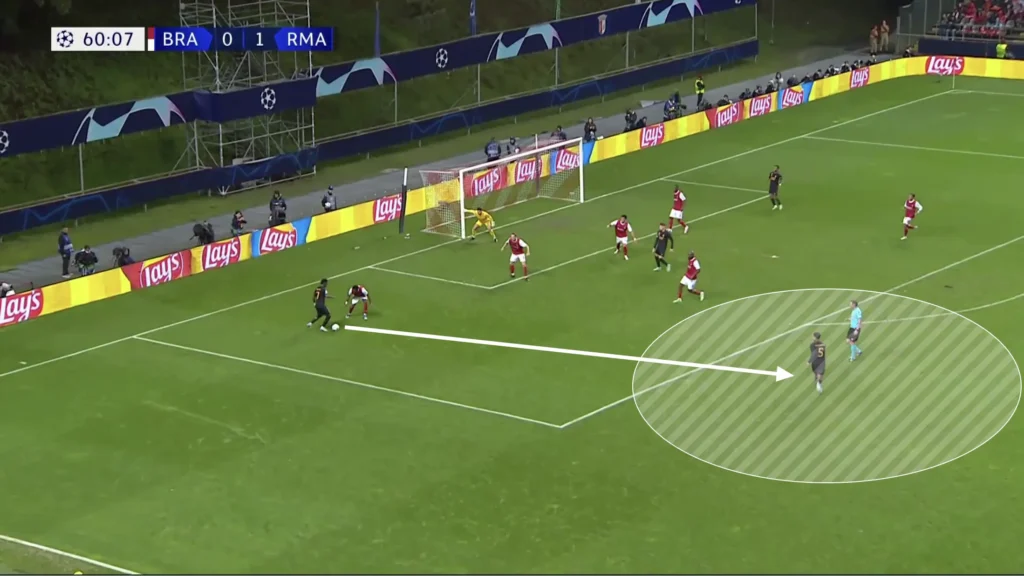
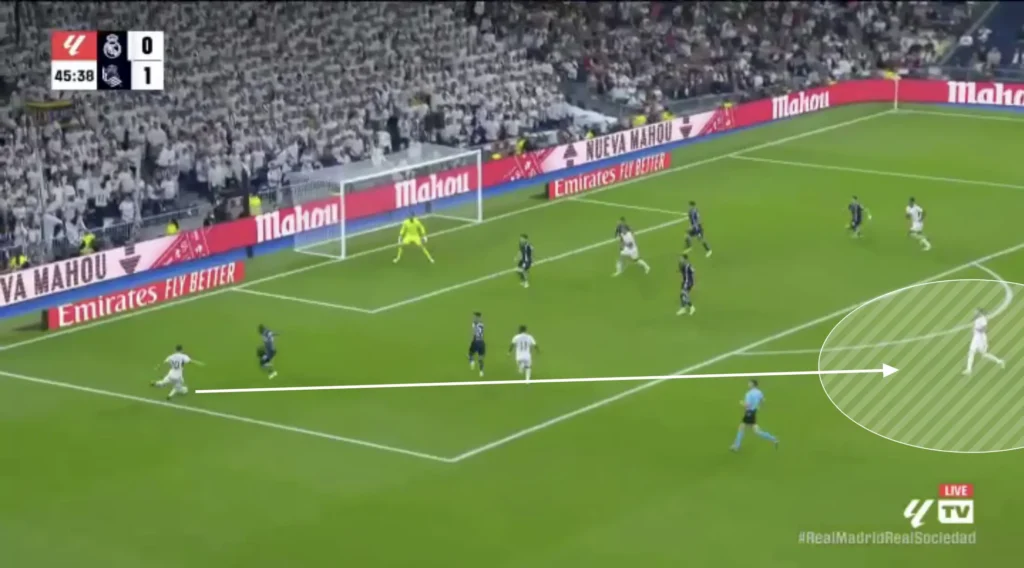
Principles and Tools
Keeping Possession
Under Carlo Ancelotti’s guidance, Real Madrid adopts a possession-based style of play aimed at controlling the rhythm and tempo of the game. The team prioritizes building from the back, with the goalkeeper often acting as the initial point of possession. Real Madrid’s defenders and midfielders are adept at circulating the ball patiently, probing for openings in the opposition’s defensive structure. Ancelotti emphasizes fluid positional interchanges, with players constantly offering passing options to maintain possession and create space. This possession-focused approach controls the game’s rhythm while wearing the opponents down, giving Ancelotti’s team more energy later in games.
Rotations and Interchanges
One influential principle in Ancelotti’s playing style is to be fluid within the system and to find different interchanges and rotations. These rotations create a lot of confusion for the opposition because they do not know whether they should follow the Real players or stay in their position. Their most frequent rotation is when the players in the half-space switch places to pull their defenders away and create more space for their teammates.
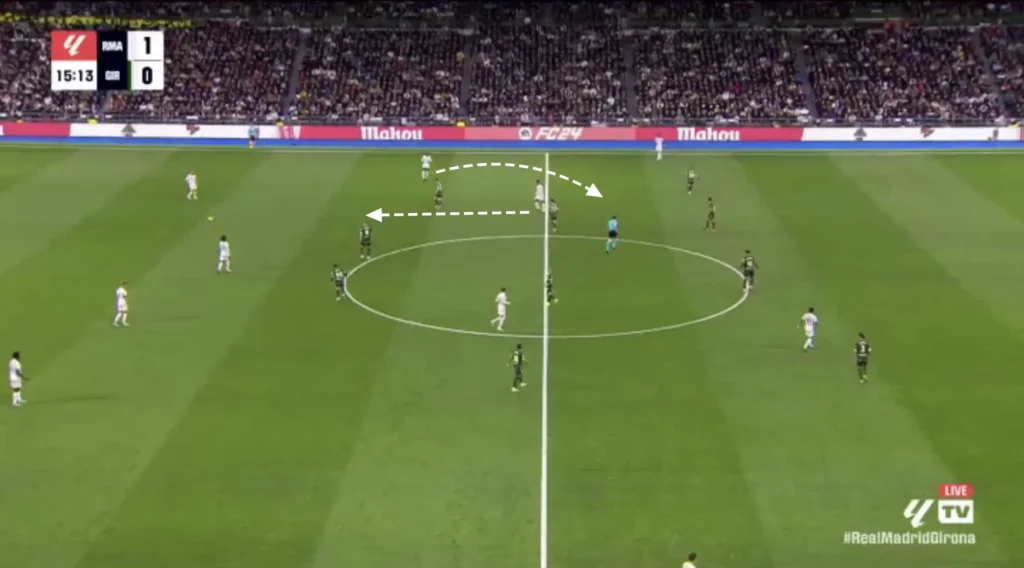
Another part of this is that everyone can play everywhere. Here, Ferland Mendy comes into an attacking midfield position from his left-back position, which creates even more confusion for the opposition.
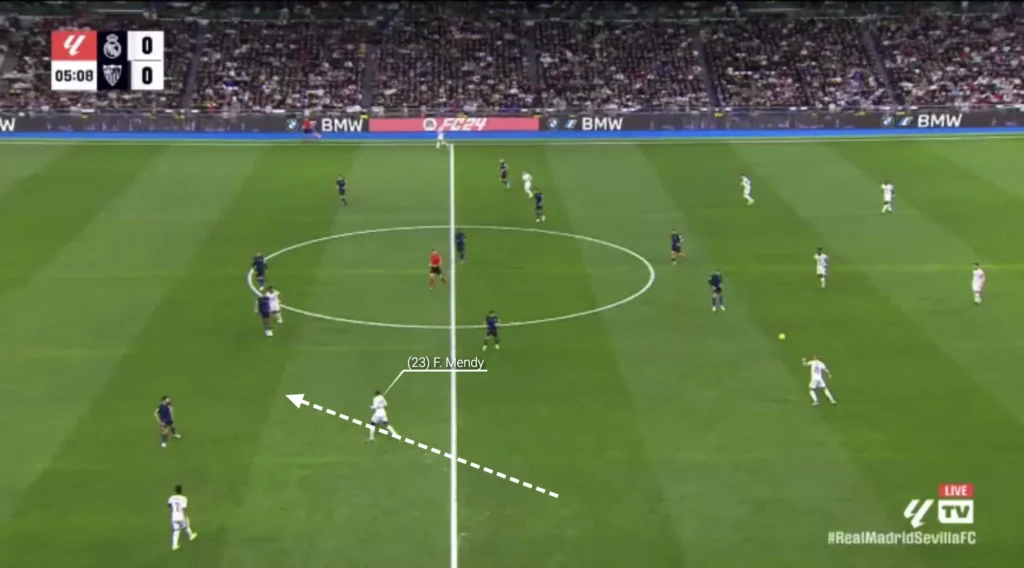
Numerical Advantages
Another massive aspect of Real Madrid’s high build-up is their ability to create numerical advantages against the opposition’s defensive line. Their front five naturally becomes numerically superior against a back four, which they are great at taking advantage of.
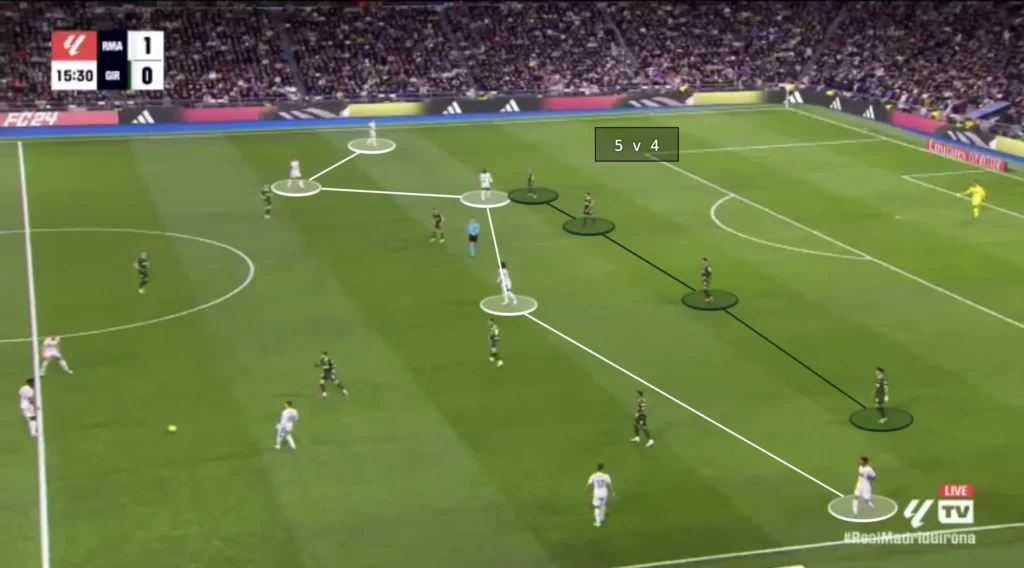
When the defending team is positioned on one side, the weak-side fullback becomes vulnerable to the long switch of play due to the 1v2 against Real Madrid’s winger and attacking midfielder. Carlo Ancelotti’s team often capitalizes on this by getting the ball to the winger and creating many opportunities from 2v1 situations on the wing and in the half-spaces.
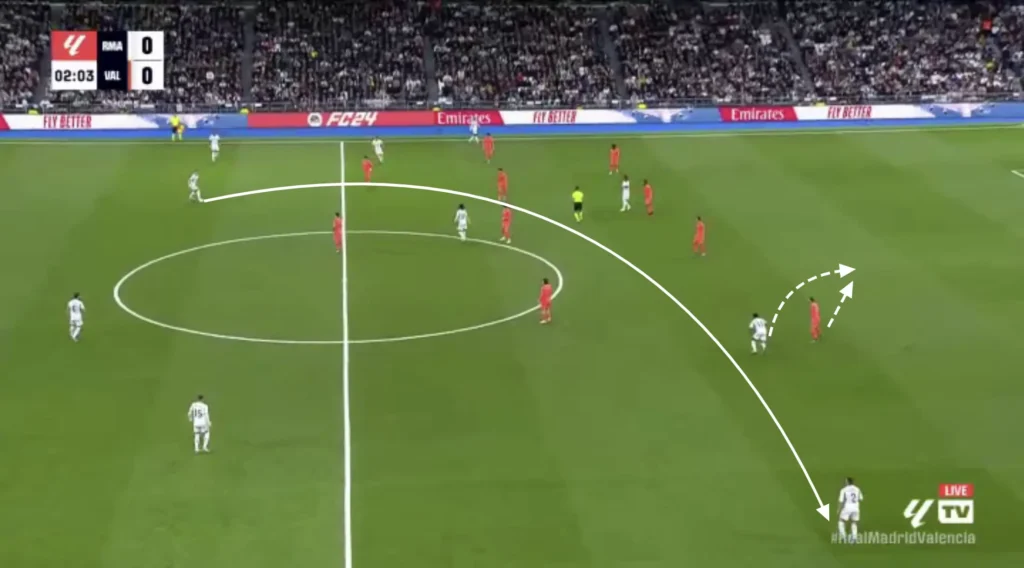
Due to their constant rotations and movement, Real Madrid often creates numerical advantages on the wing. Sometimes, the striker will come wide or the weak-side attacking midfielder. These numerical superiorities allow them to play past their opponents by always finding a free player.
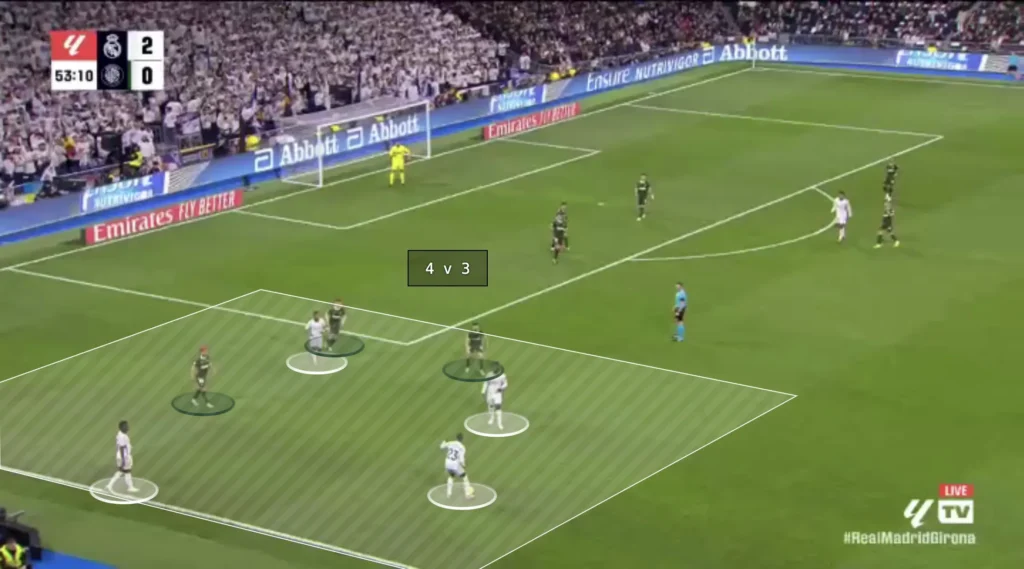
Defending
High Press
Carlo Ancelotti places much value in being aggressive without the ball. This shows in Real Madrid’s high pressure. Ancelotti usually wants his team to go man-to-man and intensely press the opposition. They do this because of their principle of being the team controlling the game, therefore always looking to have possession.
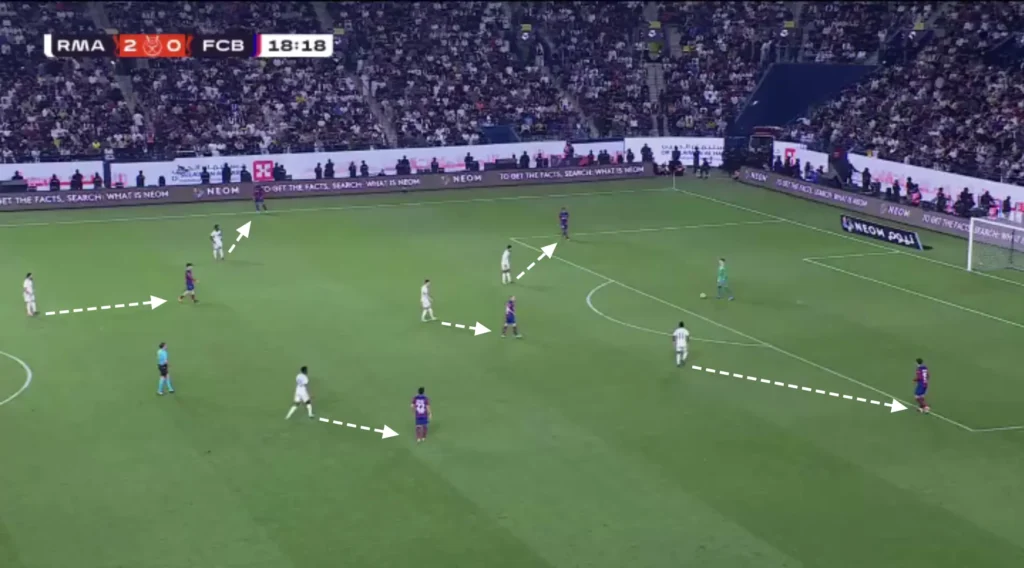
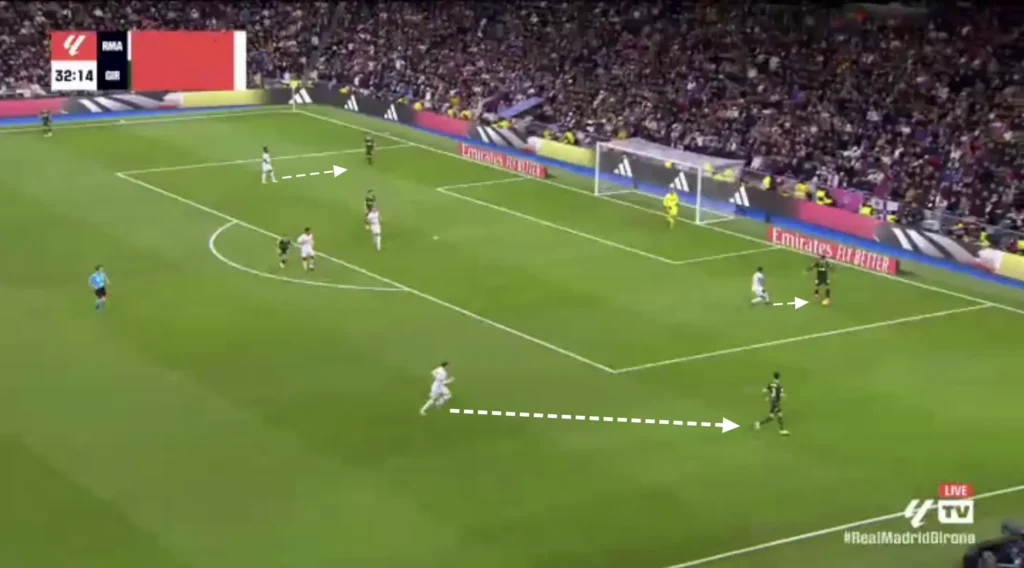
Low Press
In the low press, Ancelotti’s Real Madrid uses a 1-4-5-1 formation. They look to set up in a mid-block, always trying to close the center, forcing the opposition out wide.
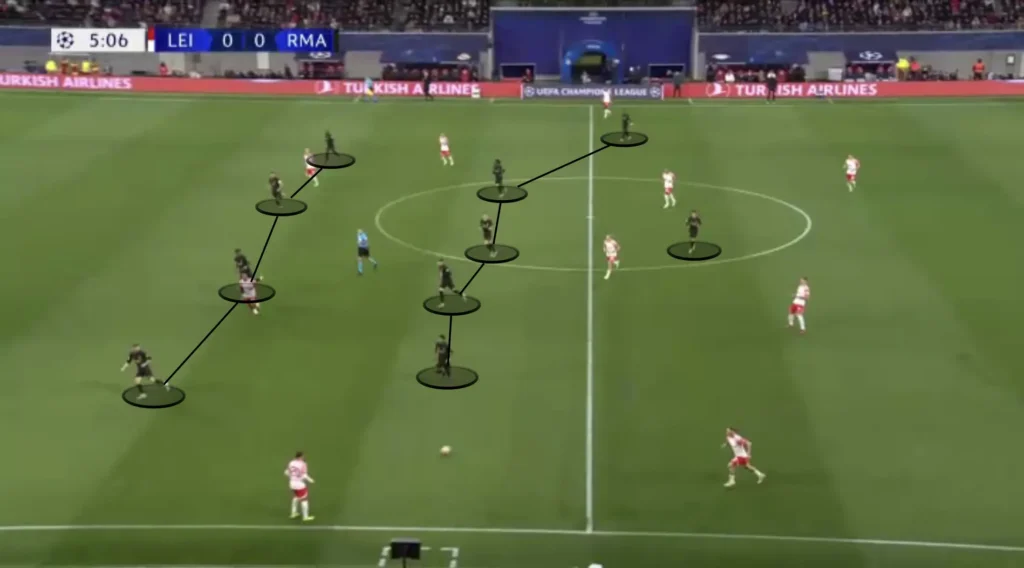
Real Madrid looks to squeeze the pitch when defending. This means constantly pushing the team up as much as possible. Every time the opponent plays a slow, sideways pass or a back pass, Real’s first line of pressure pushes up, with the rest of the team following to stay compact. When the next pass comes, they push up even more, forcing the opponent back even more. They do this because it pushes the opponent further away from Real’s goal, making it harder to create chances.
To prevent the opposition from switching the play, Ancelotti positions the weak-side winger close to the weak-side center-back, blocking the pass. This discourages the opposition from playing the ball to him, taking away the easiest way to switch the play. This also gives the winger a better position for offensive transitions. He will be closer to the goal and ready to join a potential counterattack.
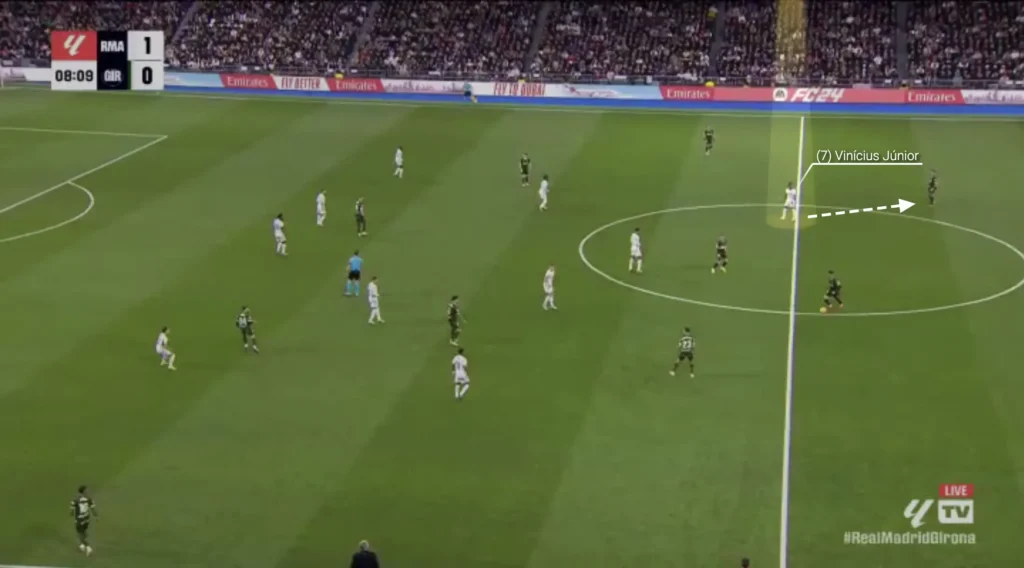
Transitions
Defensive Transitions
Positioning many players centrally, creating a numerical advantage in the midfield, creates good conditions in defensive transitions. Many players close to the ball after losing possession means that many players can work towards regaining possession. Ancelotti’s team, therefore, often regains possession directly after losing it.
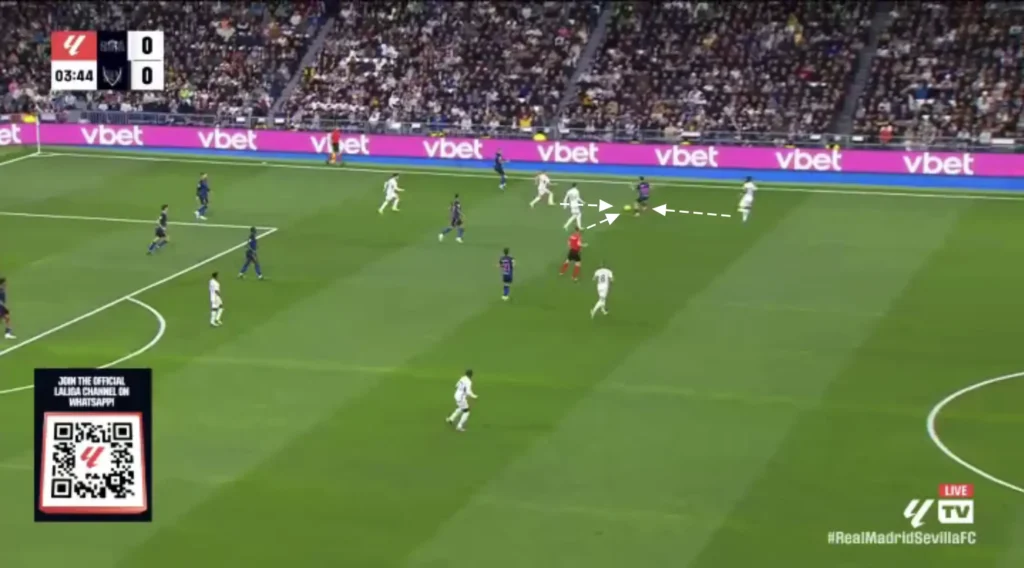
Offensive Transitions
Arteta also wants his team to counterattack in their offensive transitions. They do this with a high tempo, often attacking the spaces between the center-backs and fullbacks. Real Madrid’s fast forwards have their greatest strengths in attacking the defense with speed. They, therefore, score many goals from counterattacks.

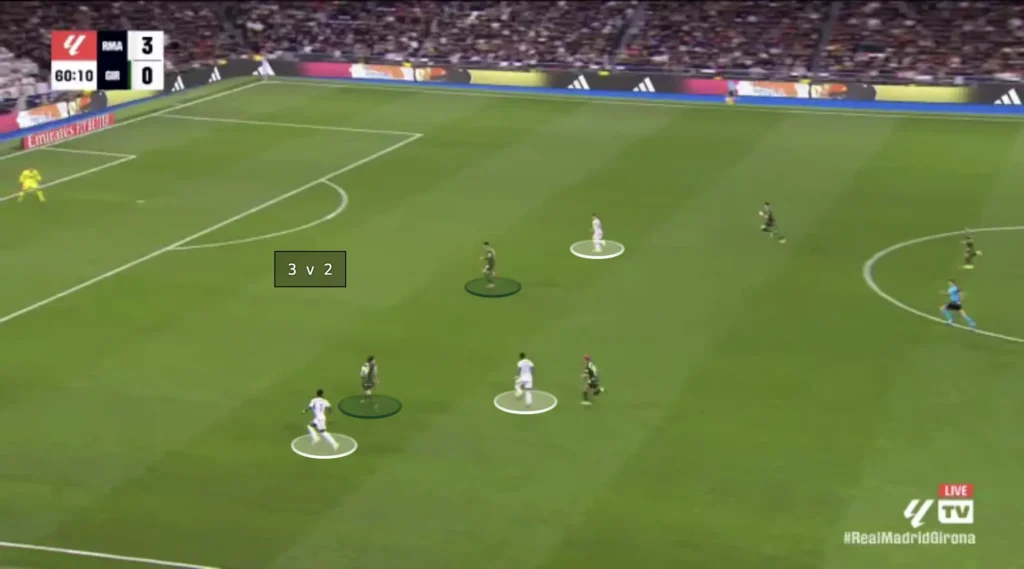
Final Thoughts
In conclusion, this tactical analysis of Real Madrid under the guidance of Carlo Ancelotti unveils a team molded with strategic sophistication and fluidity. Ancelotti’s tactical philosophy, blending defensive solidity with attacking flair, is evident in the team’s formations and player movements. The adaptability to shift between systems and the emphasis on player roles contribute to Real Madrid’s success on the pitch. The utilization of key players and the integration of young talents showcase Ancelotti’s adept management. As Real Madrid continues to navigate through the remainder of the season, Ancelotti’s tactical knowledge will be a pivotal factor in the team’s pursuit of triumph, illustrating a harmonious balance between defensive resilience and attacking prowess.
